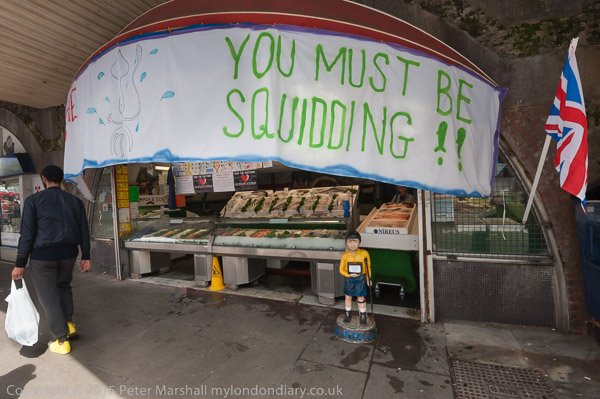
L S Mash & Sons has been in Brixton Arches since 1932. Network Rail are evicting them and the other shops
The final weekend of April was dominated for me by housing and the related issue of gentrification and regeneration. Housing has always been tight in London, particularly for those will little money, and it’s something that has always been an issue. In the Victorian era, philanthropists set up various housing associations and companies to provide housing of a decent standard for the poor and tore down many of the worst slums to build large blocks of flats.
It wasn’t always if ever a fair or comfortable process for those whose slums were demolished, many of whom found themselves out on the streets and had to squeeze themselves into the already overcrowded slums adjacent to the new blocks, but it did provide a great deal of decent living space for the working poor who moved into the new buildings. And there was no doubt that the intentions of those driving the process was good, even if they did also want to provide a sensible return for investors who financed some of the schemes.
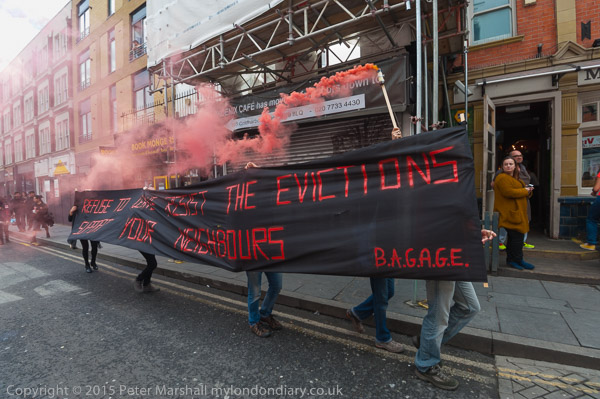
Brixton Action Group Against Gentrification and Evictions banner ‘Refuse to Move – Resist the Evictions – Support your Neighbours’
In the first three-quarters of the twentieth century, the London County Council and the local councils across London took up the challenge of providing decent low cost housing for Londoners who needed to live in the capital where they worked. Many small and large estates were developed across London, as well as new areas on the outskirts and later new towns outside of London. Private developers too built huge estates mainly in the outer suburbs for the middle classes who could commute to work by train and increasingly by car. Huge numbers of housing units were provided at costs which London’s workers could afford, although councils still had long waiting lists of people living in poor or cramped accommodation who wanted to move into council property.
In the last quarter of the twentieth century, things began to go spectacularly wrong. Thatcher’s ‘Right to Buy’ was one of the the first straws, and while providing a huge bonus for the lucky few who got their property at a knock-down price (though many could not afford to keep it long), it was not matched by any attempt to replace the low-cost housing that was taken out of council hands. Other measures actually took most of the housing out of council hands and created housing associations, which in the longer term have also been a disaster for the poor. The final straw has become the building of properties in London simply as investment vehicles for overseas buyers. I don’t think any solution to the crisis can be found unless this is very severely curbed in some way, perhaps by a punitive tax on sales by or on behalf of overseas residents.
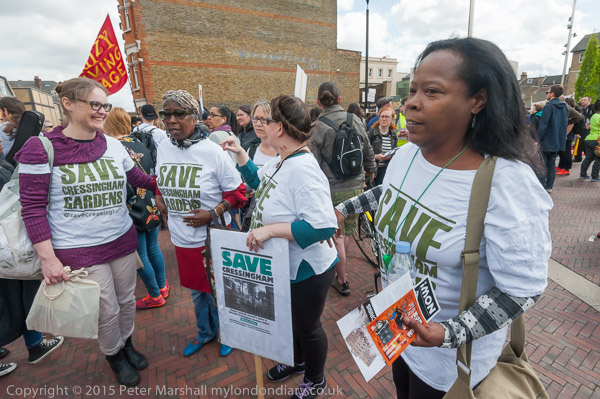
Not only is Lambeth council going to evict Cressingham Gardens tenants, it wants to charge each of the £14,000 for renovations before it knocks their properties down
Regeneration programmes were perhaps brought in by the Labour government with good intentions, but if so these have now been subordinated to profit and greed. Labour councils, realising the huge financial potential of their large well-located council estates for redevelopment began to ‘decant’ those living in prime sites so that they could be developed for private and overseas sale at much higher densities than the well-planned estates that are being demolished. Increasingly developers of these sites are finding ways to avoid meeting any need to include social housing in their redevelopment, with councils (who are mainly under Labour control) conspiring to help them do so.
Gentrification involves more than this, but the cost of housing is a major part in this, along with the changing nature of employment, and of changes in culture. The people who live in ‘up and coming’ areas of London bear the brunt of the process, getting priced out of the market, decanted from council and housing association properties, usually moved well out of the area and away from jobs and friends, and often having to move into private rented property with little or no security and high and increasing cost.
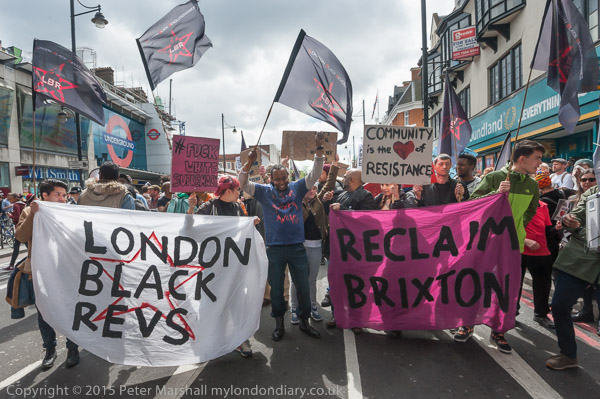
Areas such as Brixton and the Elephant in south London are under particularly high stress, in part because they have long been unfashionable with historically low house prices (for London) but also because of their location, close to the centre of London with excellent transport links. Brixton has the added attraction of a particularly vibrant culture, mainly based around exactly those people and businesses that are now finding they can no longer afford to live there.
The railways run through the centre of Brixton, with Atlantic Road alongside the rail arches and above it Brixton Station. Around the corner a few yards away on the Brixton Road are the underground station and bus stops for the many routes that make Brixton something of a bus hub. At right angles in its centre is Electric Avenue with its incredible street market – and the market also extends in the other direction to the north of the railway lines with more small businesses in the arches there. Running from Atlantic Road to Coldharbour Lane are the arcades of ‘Brixton Village’, increasingly catering for the new, young middle-class that are beginning to take over the area, and there are other arcades to the south as yet less affected.
It’s a unique centre in London, and I can think of nothing like it elsewhere in this country. I’ve been going there occasionally for years, at first to buy cut-price photographic materials – outdated bulk film and paper – and later to Photofusion, where I put pictures in their library and went to exhibition openings.
Surrounding the centre are some areas of Victorian terraces, but also huge housing estates built by the London County Council and local councils, as well as some by the philanthropic housing companies. All these are now under threat, as all could be demolished and rebuilt at higher densities for sale at huge profits. Most of the properties are in reasonable condition, built to higher standards in many respects, particularly size, than new properties, though often in need of some refurbishment. Typically this might cost £15,000 per property, while building a new council flat costs perhaps £350,000. But flatten the site, build twice as many flats and sell them at market price, perhaps £600,000 gives considerable margin.
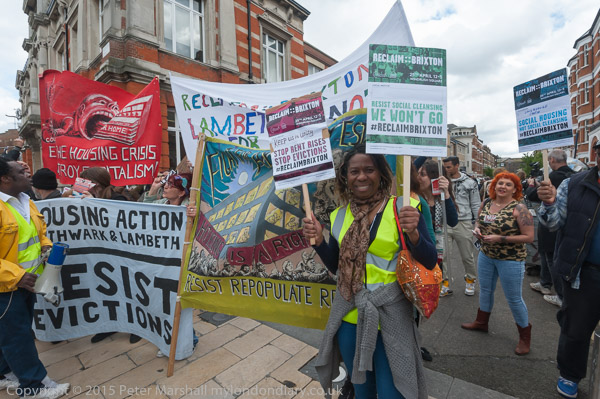
Reclaim Brixton brought together many different groups who see their lives and their culture at risk. The small businesses in the railway arches and arcades, currently threatened by huge rent hikes from the owners Network Rail which will put them out of business. A number have been there more or less since the war, and at least one for longer, but they can’t afford to pay three times their current rent. People living in private rented property where rents keep rising and rooms are getting harder and harder to find. People from housing estates currently under threat of eviction, including Cressingham Gardens and the Guinness Trust Estate, as well as supporters from similar campaigns from around London. And many Brixton residents who see the aspects of the area they love – particularly pubs, cafes, shops and small businesses – being replaced by those catering for the new richer residents moving in to the area.
Much of Brixton’s vitality comes from the high proportion of people who came to live there from the West Indies, moving to Brixton as many from the early arrivals were given temporary housing in the area and they found jobs from the Brixton Labour exchange. It became an area where Africans and West Indians felt more welcome than much of London and the black population grew, opening shops and businesses there. The vitality of the area along with cheap rents (and squats) attracted others too, both black and white, including many young artists and musicians, some of whom have now grown old there.
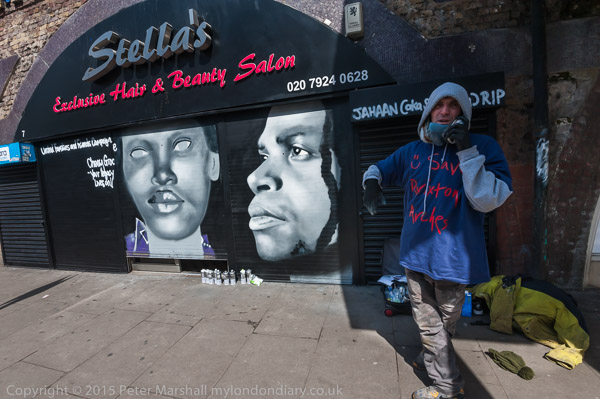
A mural on a shop front in Brixton Arches with images of Cherry Groce and Sean Rigg, just two of those killed by police in Brixton.
It’s hard to understand the events there both on this Saturday and in the past without knowing the background – and there is much more than I’ve written above, particularly for example about the relationship with the police and events such as the ‘Brixton Riots‘ and the various deaths in police custody in the area.
I divided my coverage of the Saturday into four stories, though they are all part of the same story. There should have been another couple of stories, but I went home early. As I stood at the bus stop I thought I would almost certainly miss things happening, but I was tired, and decided that plenty of others were present who would record them. I keep telling myself that I can’t do everything and sometimes at least have to admit my age.
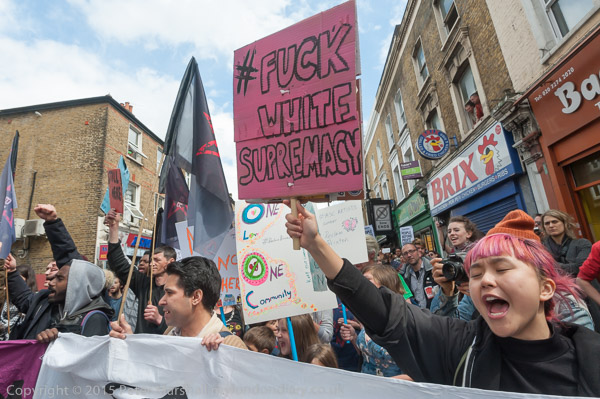
So I went home, fully expecting that things would kick off, that there would be some at least minor friction between protesters, police and authority that was likely to make the headlines, while most of what led up to this and I had covered would somehow not be news. What did happen – a short-lived occupation of the Lambeth council offices and the breaking of the windows of the most notorious estate agents – was actually rather less than I had expected.
The four stories I sent in, from earlier in the day were:
Brixton Arches tenants protest eviction showing some of the businesses in the railway arches which I think all closed for a couple of hours across the middle of the day as a protest;
Take Back Brixton against gentrification, a planned march from outside Brixton Village to Windrush Square involving mainly groups concerned with housing issues;
London Black Revs ‘Reclaim Brixton ‘march, a ‘spontaneous’ march around central Brixton involving all the more radical groups and individuals leaving and returning to Windrush Square,
Reclaim Brixton celebrates Brixton, an organised static event in Windrush Square at the centre of the protest with various groups setting up stalls, making speeches in different areas.
______________________________________________________
My London Diary : Buildings of London : River Lea/Lee Valley : London’s Industrial Heritage
All photographs on this and my other sites, unless otherwise stated, are taken by and copyright of Peter Marshall, and are available for reproduction or can be bought as prints.
To order prints or reproduce images
________________________________________________________